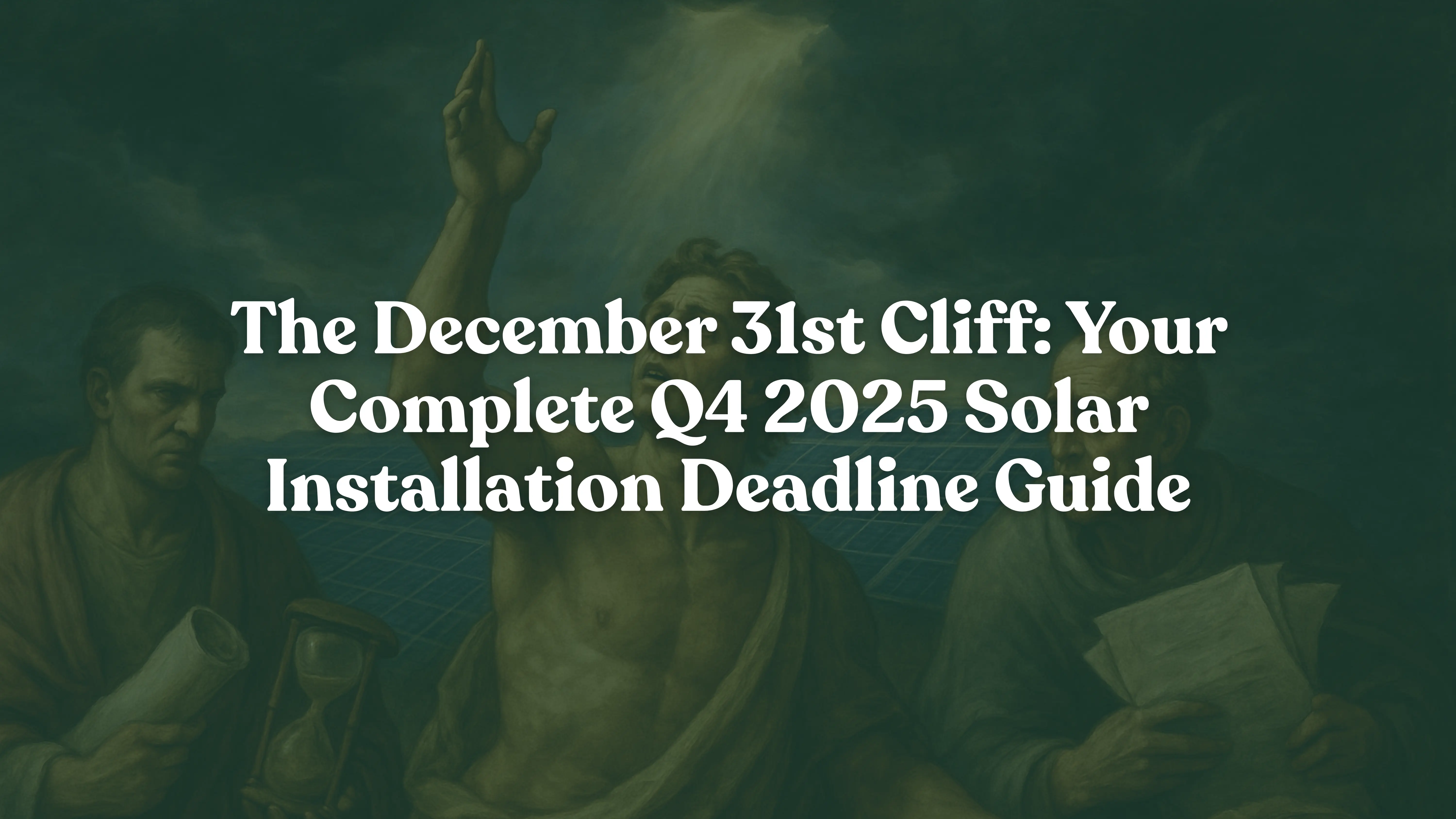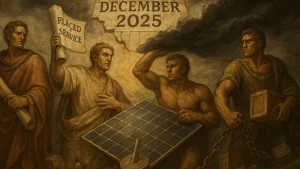Solar Incentive Deadlines 2025: State-by-State Guide

Solar Incentive Deadlines 2025: Q4 Installation Rush Guide for Installers
The solar incentive deadlines 2025 are creating unprecedented pressure across the industry. With the federal tax credit ending December 31st and multiple state programs closing simultaneously, installers and EPCs face the most intense quarter in solar history. Moreover, understanding these deadlines could mean the difference between securing thousands in customer savings or losing projects entirely.
Here’s what makes this different: it’s not just one deadline. Instead, you’re managing federal requirements, state-specific cutoffs, utility interconnection timelines, and funding caps—all converging in Q4 2025.
Why December 31, 2025 Changes Everything for Solar Professionals?
The federal Investment Tax Credit (ITC) was scheduled to phase down gradually through 2034. However, the One Big Beautiful Bill, signed July 4, 2025, eliminated that timeline. Consequently, the residential 30% solar tax credit drops to zero percent on January 1, 2026.

For context, the average 8 kW residential system costs $23,840 before incentives. That 30% credit saves customers $7,152. Miss the deadline by one day? That savings disappears completely.
But there’s more to consider. The IRS “placed in service” requirements demand more than a signed contract. Your system must be installed, operational, and generating electricity by December 31st.
This means:
- Completed physical installation
- Passed final inspections
- Approved utility interconnection
- System capable of generating power
- Permission to Operate (PTO) obtained (where required)
Since PTO alone takes 2-3 weeks in many jurisdictions, you’re working with a deadline that’s essentially mid-December for guaranteed compliance.
Understanding “Placed in Service” Requirements: A Detailed Breakdown
Let’s clarify what the IRS actually requires. According to Notice 2018-59, “placed in service” means your solar system is ready and available for its specifically assigned function.
Critical Compliance Steps
Step 1: Complete Physical Installation
All panels must be mounted. Inverters connected. Electrical work finished. Additionally, weatherproofing should be complete.
Step 2: Pass Final AHJ Inspection
Your local Authority Having Jurisdiction must inspect and approve the installation. Furthermore, obtain all required sign-offs and certificates.
Step 3: Submit and Approve Utility Interconnection
File interconnection applications early. Most utilities require review and approval before energizing systems. Therefore, submit applications immediately after contract signing.
Step 4: Verify System Functionality
The system must be operational and capable of generating electricity. In other words, it can’t just be installed—it must work.
Step 5: Obtain Permission to Operate
Many utilities require explicit PTO before sending power to the grid. Consequently, this step often becomes the bottleneck in Q4.
Learn about Top 5 States Where Solar Installers Are Thriving Despite ITC Expiration. Click Here Now.
State-by-State Solar Program Deadlines: What You Need to Know Now
New York: Multiple Incentive Layers with Distinct Timelines
New York offers exceptional solar incentives, but timing is critical. The NY-Sun program operates on a first-come, first-served basis with limited annual funding.
Key NY Deadlines:
- NY-Sun applications: Submit immediately—funding depletes quarterly
- State tax credit: 25% of costs (up to $5,000) continues beyond 2025
- PSEG Long Island: Quarterly windows—check current schedule
- NYC property tax abatement: Apply within one year post-completion
Action Item: Don’t wait for contract finalization. Submit NY-Sun applications as soon as projects are likely to proceed. Otherwise, you risk funding depletion.
The state achieved its 6 GW solar goal in fall 2024, demonstrating robust program success. Nevertheless, continued funding depends on legislative action and budget allocation.
New Jersey: SREC-II Program Maximizes Customer Value
New Jersey’s Successor Solar Incentive (SuSI) offers SREC-IIs valued at approximately $90 per megawatt-hour. Combined with federal credits, customers can reduce costs by over 50%.
Critical Timeline: Registration must occur before installation begins. With the federal deadline surge, expect processing delays throughout Q4.
Pro Tip: Submit SuSI registrations at least 4-6 weeks before planned installation dates. This buffer prevents delays from impacting federal tax credit eligibility.
Illinois: Adjustable Block Program Capacity Management
The Illinois Shines Adjustable Block Program requires approved project status before installation. Current blocks fill faster than historical averages due to the 2025 deadline rush.
Strategy: Check block capacity weekly. Move approved projects to installation immediately. Additionally, communicate clearly with customers about waitlist positioning.
California: Post-NEM 3.0 Strategic Considerations
California’s solar property tax exemption continues through 2025. However, NEM 3.0 reduced export compensation rates significantly. Therefore, focus on battery storage systems to maximize customer value.
Remember: the federal ITC covers batteries with at least 3 kWh capacity. This creates compelling bundled offerings for California customers.
Maryland: Strong SREC Market Beyond Federal Deadline
Maryland’s Solar Renewable Energy Certificate market remains valuable, with systems earning $400+ annually. The state property tax exemption and certain county programs (worth up to $5,000 yearly) extend beyond December 31st.
Future Opportunity: Maryland represents strong post-2025 market potential for installers transitioning away from residential-only focus.
Read about One Big Beautiful Bill Solar Kills Credits: Reshape Your Business?. Click here
Managing the Q4 Installation Surge: Four Essential Strategies
Strategy 1: Prioritize Permitting Speed and Accuracy
Permitting delays kill projects. Therefore, submit permit-ready plan sets immediately—even while finalizing customer financing.
Implementation Steps:
- Partner with experienced engineering firms familiar with local AHJs
- Use standardized plan templates for faster approvals
- Submit complete applications to avoid rejection cycles
- Follow up weekly on pending permits
Some jurisdictions report 6-8 week review times due to volume. What typically takes two weeks could stretch into January without proactive management.
Strategy 2: Communicate Timeline Realities to Customers
Many homeowners believe signing a contract guarantees their tax credit. That’s incorrect, and this misunderstanding creates significant liability.
Clear Communication Framework:
- Explain “placed in service” requirements during initial consultation
- Include deadline language in contract fine print
- Provide written timeline estimates with buffer periods
- Offer completion date guarantees or prorated refunds for delays
Transparency builds trust. Furthermore, it protects your business from disputes when delays occur.

Strategy 3: Build Robust Weather and Inspection Buffers
A three-day installation easily becomes two weeks with weather delays and inspection rescheduling. Consequently, conservative scheduling protects both parties.
Buffer Recommendations:
- Add 5-7 days for weather contingencies
- Schedule inspections with 2-week advance notice
- Book utility interconnection appointments immediately
- Plan December installations for mid-month completion target
If booking into November or December, be explicit about deadline risks during sales conversations.
Strategy 4: Secure Equipment Supply Chain Commitments
Equipment lead times extend as demand spikes industry-wide. Therefore, lock down inventory commitments now for your Q4 pipeline.
Supply Chain Actions:
- Confirm delivery dates in writing from distributors
- Consider bulk purchases if financially feasible
- Identify backup suppliers for critical components
- Communicate lead times to customers during proposal stage
Post-December 31st: Strategic Opportunities for Forward-Thinking Installers
The residential credit ends, but solar opportunities continue. Smart installers pivot their strategies now to maintain momentum in 2026.
Commercial and Light Commercial Markets
Commercial projects qualify for the Section 48E Investment Tax Credit through 2027. Target these opportunities:
Small Businesses: Retail stores, restaurants, office buildings with high daytime usage
Educational Facilities: Schools, daycare centers, vocational training centers
Light Industrial: Warehouses, manufacturing facilities, distribution centers
Medical Offices: Clinics, dental practices, outpatient facilities
Commercial projects feature larger system sizes, longer sales cycles, but more stable revenue per installation.

Nonprofit and Municipal Sector Growth
Churches, community centers, and municipal buildings represent significant untapped potential. These organizations benefit from:
- Long-term energy savings benefiting tight budgets
- Available state and utility incentives
- Community goodwill and environmental leadership
- Reduced operational expenses for mission-critical work
Community Solar Development Expansion
Community solar programs allow customers to access solar benefits without rooftop installations. This model serves renters, homeowners with unsuitable roofs, and businesses without adequate space.
Many utilities expand community solar offerings as federal residential incentives end. Consequently, this creates new partnership opportunities for installers transitioning to utility-scale work.
Battery Storage Emphasis for Existing Customers
Stand-alone battery storage systems serve existing solar customers seeking energy independence and backup power. Additionally, new customers in high-rate areas find storage-only systems financially attractive.
High-Value Markets After Federal Incentive Changes
Solar remains economically viable in states with favorable conditions. Focus on these characteristics:
High Electricity Rates: New York (26.67¢/kWh), California, Massachusetts, Hawaii
Strong State Incentives: Tax credits, rebates, SREC programs
Favorable Net Metering: Full retail rate compensation for exports
Property Tax Exemptions: No assessment increase from solar value
These markets offer sub-10-year payback periods even without federal incentives. Therefore, they represent sustainable business opportunities through 2026 and beyond.
Ready for Q4 — Energyscape Renewables Keeps Your Projects On Track
Q4 is a race against deadlines and paperwork. Energyscape Renewables delivers end-to-end solar engineering—permit-ready plan sets, rapid PE stamping, interconnection support, and fast-turnaround design so you can submit permits, hit “placed in service,” and protect customer credits.
Sunscape (Site Survey App + CRM) captures accurate field data, automates workflows, and keeps customers updated—so your sales, design, permitting, and field teams move together, not in silos.
Short version: act fast, standardize your documentation, and let Energyscape + Sunscape be the single partner that helps you close Q4 projects cleanly and profitably.
Frequently Asked Questions About 2025 Solar Deadlines
When does the solar tax credit end?
The federal residential solar tax credit ends December 31, 2025 at midnight. Systems must be fully installed and operational by this date to qualify for the 30% credit.
What does “placed in service” mean for solar installations?
“Placed in service” means your solar system is installed, inspected, approved by utilities, and capable of generating electricity. It’s not enough to just sign a contract—the system must be operational.
What are the solar program deadlines in New York?
New York’s NY-Sun program operates on first-come, first-served funding throughout the year. The state tax credit (25% up to $5,000) continues beyond 2025. PSEG Long Island has quarterly application windows.
Can I still claim the tax credit if PTO delays past December 31st?
The IRS may allow flexibility if utility delays prevent PTO despite completed installation. However, this is uncertain. The safest approach is completing all steps by mid-December.
What happens to solar installations after the federal credit ends?
Solar remains viable in high-electricity-cost states with strong local incentives. Commercial projects still qualify for Section 48E credits through 2027. Additionally, battery storage and community solar present new opportunities.
How long does solar permitting take in Q4 2025?
Permitting timelines vary by jurisdiction. Expect 6-8 weeks in high-volume areas, compared to typical 2-4 week timeframes. Submit complete, permit-ready applications to avoid delays.

sjayakanth@energyscaperenewables.com